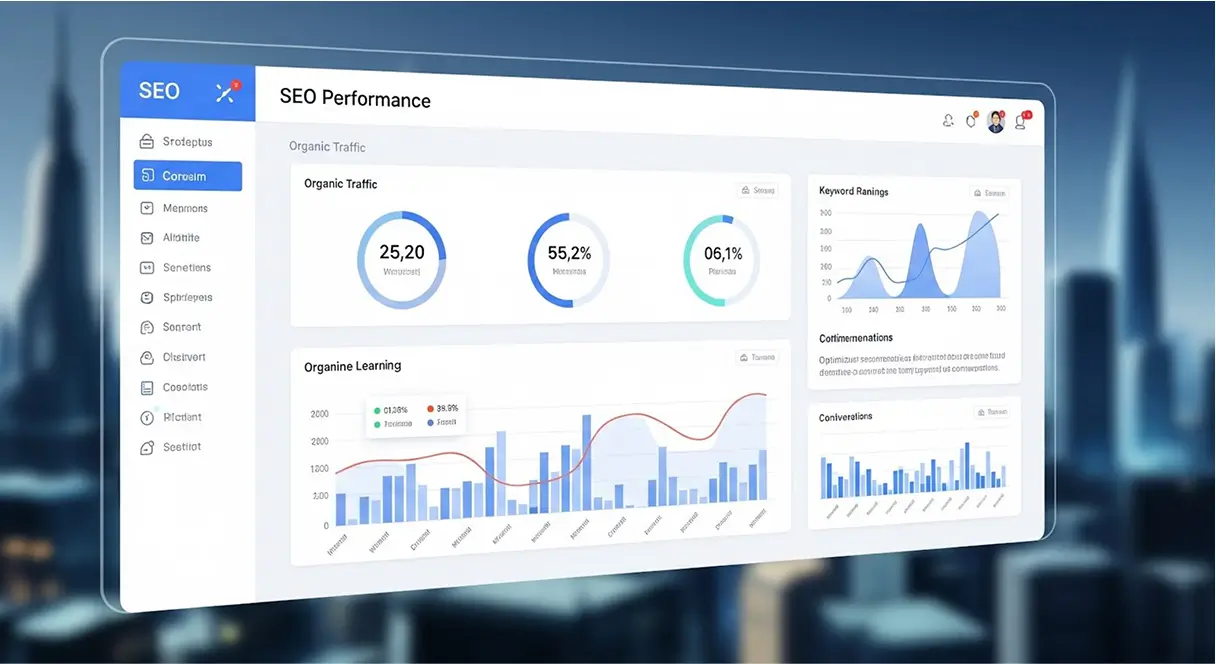Table of Contents
- How Data-Driven Dashboards Are Redefining Agency Success
- Why SEO in 2025 Is a Full-Funnel Game
- The Agency Challenge: Too Much Data, Too Little Insight
- Data-Driven Dashboards: The 2025 Growth Engine
- Centralized Data for Smarter Decisions
- Real-Time Alerts and Actionable Insights
- Transparent Reporting Builds Trust
- Turning Metrics into Action: Data-Driven Optimization
- Automation: The Silent Growth Engine
- Must-Have Features for a 2025 SEO Dashboard
- Case Example: How an SEO Agency Improved Retention with a Unified Dashboard
- Unified Visibility
- Real-Time Alerts
- Client Trust & Retention
- What Industry Leaders Are Saying About SEO Reporting in 2025
- What Platforms Are You Using for SEO Dashboards and Reporting?
- What Benefits Have You Seen From Centralized Reporting?
- Which Metrics Do You Always Include?
- Closing Thoughts: From SEO to Strategic Growth
How Data-Driven Dashboards Are Redefining Agency Success
Did you know that around 60% of Google searches now result in zero clicks, and on mobile, that number spikes as high as 77%?(Semrush, UpAndSocial) For agencies, this isn’t just a statistic—it’s a wake‑up call.
The classic “10 blue links” era is gone. Rank tracking for keywords is no longer enough; SEO in 2025 is about guiding customers through every stage of the funnel.

AI‑powered search, voice interfaces, and hyper‑local queries have disrupted the SEO ecosystem. Traditional metrics like rankings and traffic do not tell the full story anymore. What separates successful agencies is their ability to see the whole journey: real‑time visibility, unified insights, and fast, strategic action.
Why SEO in 2025 Is a Full-Funnel Game
SEO now impacts awareness, consideration, conversion—even retention. With AI overviews and enhanced snippets, user behavior has shifted dramatically:
- Only 8% of users click a traditional result when an AI‑generated summary appears, compared to 15% without one (AgencyAnalytics, Search Engine Land).
- Top‑ranking CTR dropped 32% since AI overviews rolled out in 2025—from 28% down to 19% (Search Engine Journal).
Agencies must now think in terms of SERP real estate, not just keyword position. Visibility today spans:
- AI Search Experiences: Google’s Search Generative Experience (SGE) summarizes, answers, and links—reshaping clicks.
- Voice & Local Queries: “Near me” searches via voice assistants are driving hyper‑local discovery.
- Multi‑Touch Journeys: Organic visits are now just one touchpoint in a multi‑channel path to conversion.
Traditional rankings‑only reporting can’t capture this complexity. Agencies need holistic dashboards that connect keywords → engagement → revenue impact.
The Agency Challenge: Too Much Data, Too Little Insight
Agencies using GA4, GSC, local listings, backlink tools, and spreadsheets in isolation have to face slow decision making and disjointed client reporting.
A unified dashboard fixes this by pulling together:
- Keyword rankings & domain authority
- Local map pack performance via local rank tracker
- Traffic & engagement metrics
- Backlink health & opportunities
Data Insight: Agencies using real‑time dashboards reduce manual reporting by 40% and detect performance dips 2x faster (HubSpot).
Data-Driven Dashboards: The 2025 Growth Engine
In 2025, agencies that rely on scattered spreadsheets are falling behind, while those harnessing real‑time, data‑driven dashboards are turning insights into measurable growth faster than ever.
Centralized Data for Smarter Decisions
Dashboards eliminate tool fatigue by consolidating:
- Organic traffic
- Keyword rankings
- Local map metrics
- Backlinks and domain authority
A Databox survey found 46% of marketers track 3–5 metrics and 40% track 6–10, focusing attention on what matters most (Databox).
Real-Time Alerts and Actionable Insights
Dashboards with anomaly detection send instant notifications when:
- A top keyword drops in rank
- A SERP feature shifts
- AI answers reduce CTR
Agencies report operational efficiency gains and higher client retention, because action is taken before revenue loss hits (Usermaven, WeCanTrack).
Transparent Reporting Builds Trust
Replace monthly PDFs with live white‑label dashboards:
- Clients see real‑time performance and ROI
- Transparency strengthens long‑term retention
Turning Metrics into Action: Data-Driven Optimization
A powerful dashboard lets agencies:
- Spot underperforming keywords and CTR drops caused by AI results
- Identify content gaps for untapped queries
- Track SERP feature changes like Knowledge Panels and AI Overviews
- Respond quickly to competitor backlink gains
Scenario: A branded keyword loses visibility. A dashboard alert triggers immediate action:
- On‑page updates
- Supportive FAQ content
- CTR recovery within a single day
Automation: The Silent Growth Engine
Dashboards automate aggregation, charts, and reports, freeing hours for strategic work.
Teams can:
- Focus on growth instead of spreadsheets
- Customize widgets for client presentations
- Scale across accounts efficiently
Industry Snapshot: Agencies using real‑time dashboards improve campaign turnaround by 35% (Semrush, Exposure Ninja).
Must-Have Features for a 2025 SEO Dashboard
- Custom KPI widgets
- GA4 & GSC integration
- Local SEO & Google Business tracking
- Competitor benchmarking
- AI‑powered anomaly alerts
- White‑label live reporting
Case Example: How an SEO Agency Improved Retention with a Unified Dashboard
A mid‑sized agency managing dozens of SEO clients faced scattered data, delays, and frustrated clients.
The Turning Point: Implementing DAXRM to centralize SEO data.
Unified Visibility
- Combined traffic, keyword rankings, local map packs, and backlinks
- Added competitor SERP monitoring
Real-Time Alerts
- 28% CTR drop detected for a top keyword after SGE AI answers
- Quick meta + FAQ refresh recovered 80% of clicks in 10 days
Client Trust & Retention
- Moved from PDF reports to live dashboards
- Clients checked progress weekly
- Retention jumped 72% to 89% in one quarter
Result: 30+ hours saved monthly, reporting turned into a growth engine.
What Industry Leaders Are Saying About SEO Reporting in 2025
What Platforms Are You Using for SEO Dashboards and Reporting?
“We use Looker Studio connected to GA4, GSC, and Ahrefs for our SEO dashboards. It pulls data together cleanly and keeps clients focused on the right numbers.”
— Bryan Philips, Head of Marketing, In Motion Marketing
“Our SEO reporting stack includes Google Looker Studio integrated with GMB Everywhere, BrightLocal, and Screpy. All data is updated daily in one dashboard, keeping things simple for clients.”
— Ramzy Humsi, Founder & CEO, Vortex Ranker
“At Assertive, we use Looker Studio and our own platform, SEO Stack. Everything from GA4, GSC, and Ahrefs is pulled in automatically so clients can see performance in real time.”
— Aly Johnson, Head of Content, Assertive
What Benefits Have You Seen From Centralized Reporting?
“Traditional reports are often bloated with data only SEO teams use. We moved to concise, one-page centralized reports that highlight what matters most to clients: traffic, conversions, and opportunities. This saves days of reporting time and adds real strategic value.”
— James Foote, Director, POLARIS
“The primary benefit has been budget optimization. Using centralized dashboards, we reduced vendor costs while still improving performance. For example, traffic grew 4% in six months and engagement rose 10%.”
— Gunnar Blakeway-Walen TD, Marketing Manager, The Duncan Apartments by Flats
“Using platforms like DAXRM or Dataslayer has improved efficiency and client trust. Automating and customizing reports means fewer errors and more transparency.”
— Evan Xidous, SEO Manager
Which Metrics Do You Always Include?
“We focus on organic revenue, goal completions like ‘Book a Consultation,’ and share of voice for the keywords that actually drive sales. Vanity metrics don’t matter.”
— Aviad Faruz, Owner, Manor Jewelry
“Key metrics we always report are organic traffic, keyword rankings, CTR, impressions, backlink growth, and technical health scores. These give clients a clear picture of visibility and opportunities.”
— James Allsopp, CEO, iNet Ventures
“We emphasize metrics tied directly to ROI: organic calls, form submissions, and improved Google Business Profile visibility. We also track review volume and sentiment, since stronger reputations directly boost conversions and allow for higher pricing.”
— Bernadette King, CEO, King Digital Pros
Closing Thoughts: From SEO to Strategic Growth
SEO in 2025 isn’t just visibility—it’s strategy. Dashboards do more than report metrics; they connect actions to ROI, making agencies faster, more transparent, and growth‑focused.
In the AI‑first era, it’s not enough to appear in search. You must appear in the answer.


